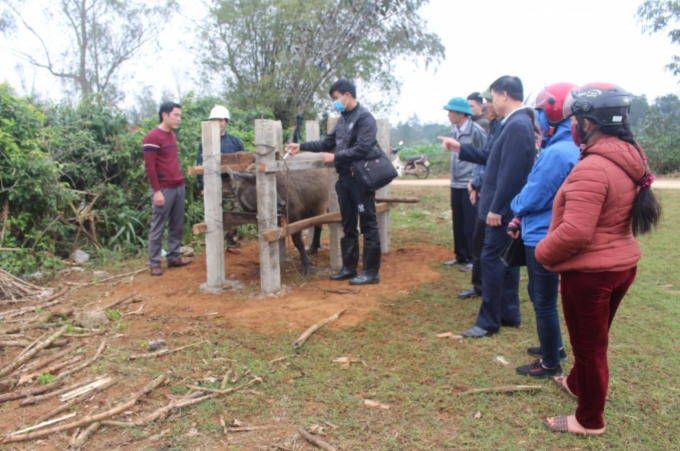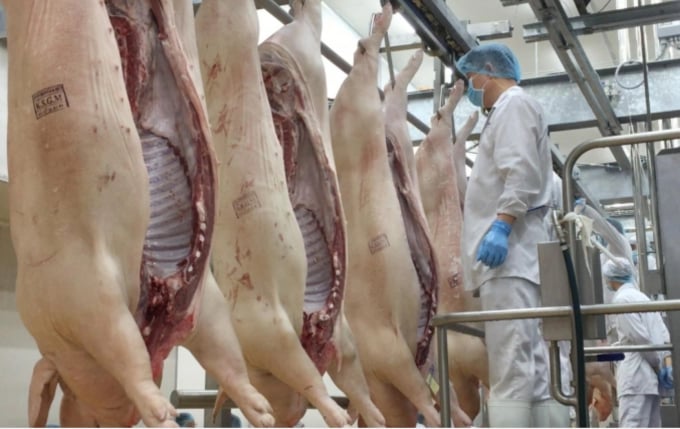May 24, 2025 | 16:26 GMT +7
May 24, 2025 | 16:26 GMT +7
Hotline: 0913.378.918
May 24, 2025 | 16:26 GMT +7
Hotline: 0913.378.918
Since the end of 2020, animal diseases have primarily been controlled in Vietnam, according to Department of Animal Health. The disease hotspots have been much narrowed down.
With regards to African swine fever virus (ASFV), Vietnam reported 207 hotspots in 27 provinces and cities at the beginning of 2021 with 2777 pigs being culled. Now, the number of hot spots has dropped to 73, found in 21 provinces and cities with 1388 pigs being killed.
According to NAVETCO National Veterinary Joint Stock Company, after pooling results in five trials, it found that the vaccine against ASFV reported 100% efficacy for vaccinated hogs and those challenged with the virus.

Pilot vaccination against African swine fever virus (LSDV) conducted in Quang Tri province. Photo: NT.
In reality, over the last three months, the vaccine has reported 80% protection for vaccinated pigs, and those challenged with the virus. This is still under examination for further results.
Ministry of Agriculture and Rural Development has directed the Department of Animal Health to develop thorough plans in order to help the business to accelerate the experiments and facilitate its vaccine registration in order to be soon adopted in agriculture. Meanwhile, the quality, safety and effectiveness of the vaccine product still need to be ensured.
With respect to Lumpy skin disease (LSD), since the outbreak in October, 2002, Vietnam has reported 81 hotspots in 38 districts of 15 provinces. 63 out of 805 infected buffaloes and cows were culled. Now, the number of hotspots has fallen to 42, which are found in 17 communes of 8 provinces, with 39 out of 771 infected cattle being killed. Ha Tinh province is hardest hit by the epidemic with 27 hotspots reported.
Recently, Ministry of Agriculture and Rural Development directed related agencies to urgently import 50,000 doses of vaccines (including 10,000 doses of Lumpyvax from Turkey, 20,000 doses of LumpyShield from Jordan and 20,000 doses of Mevac LSD from Egypt) to conduct pilot vaccination program and epidemic prevention in 08 provinces (Son La, Ha Giang, Thai Nguyen, Lang Son, Hoa Binh, Ninh Binh, Ha Tinh and Quang Tri) and some dairy farms.
According to reports of localities, 27,226 buffalos and cows have been vaccinated. The result is that vaccinated cattle do not get the infection. Specifically, those which are vaccinated with Lumpyvax of Turkey produce antibodies against LDSV after 28 days.
According to Minister of Agriculture and Rural Development Nguyen Xuan Cuong, in 2020, the sector of animal husbandry faced with a series of challenges, such as outbreaks of animal disease, Covid-19 pandemic and natural disasters.

Hog farming which experienced a year of unprecedented challenges in 2020, aim high in 2021 in particular and in the 2021 - 2030 period in general. Photo: TL.
Nevertheless, animal husbandry still enjoyed a record growth of 6.54%.
Pig herds managed to rebound after swine fever. This means the pork supply could recover to stabilize the domestic pork market.
The sector also promptly managed to recover after the historic floods and storms, in order to ensure local people’s livelihoods and the high demand at the year’s end in the central provinces.
The sector restructuring was seen in many key aspects, especially poultry farming, food processing and exports of livestock products. The mechanisms and long-term development plans for the sector were developed.
It is worth noting that diseases in farm animals were well controlled. Measures were quickly taken in order to stop the introduction and spread of the disease in the country and across the border.
Trade promotion and exports of livestock products continued to be implemented effectively, amid Covid-19 pandemic. This contributed to the overall growth of the sector.
Minister Nguyen Xuan Cuong stressed that from 2021, the industry will witness both challenges and great opportunities.

Minister Nguyen Xuan Cuong underscored that in addition to modern livestock farming, it is necessary to tap the strengths of agricultural household model. Photo: Le Ben.
In recent years, the animal husbandry is considered to witness the fastest growth in terms of science and technology compared to other fields in the agriculture sector. Many opportunities for exports can be seen.
The Minister suggested the management system in the livestock industry needed further review and rectification. More administrative reforms, application of digital technology, and engagement of different stakeholders need to be enhanced.
At the same time, the sector also needs to expand its export markets, especially in Russia and Brazil, among others.
Translated by Thu Hang

(VAN) The People's Committee of Tra Vinh province has approved an adjustment to the investment policy for the Green Hydrogen Plant project, increasing its area to approximately 52.76 hectares.
![Reducing emissions from rice fields: [2] Farmers’ commitment to the soil](https://t.ex-cdn.com/nongnghiepmoitruong.vn/608w/files/news/2025/05/05/dsc08881jpg-nongnghiep-140632.jpg)
(VAN) Clean rice cultivation model in Thuong Tan commune, Bac Tan Uyen district, is assisting local residents in achieving sustainable agriculture by substantially reducing costs, increasing productivity, and protecting the environment.

(VAN) At the conference to disseminate Resolution No. 68, AgriS introduced its digital agricultural ecosystem and reaffirmed its commitment to accompanying the Government in promoting private sector development and sustainable agriculture.

(VAN) 'Blue Ocean - Blue Foods' initiative is designed to restore marine ecosystems and establish sustainable livelihoods for local communities by cultivating a minimum of 1,000 hectares of cottonii seaweed in the first three years.
/2025/05/21/4642-3-112707_603.jpg)
(VAN) The V-SCOPE project has made direct contributions to three out of six pillars of the Comprehensive Strategic Partnership between Vietnam and Australia.

(VAN) Facing the threat of rabies spreading to the community, Gia Lai province urgently carries out measures to vaccinate dogs and cats on a large scale.

(VAN) Disease-free livestock farming not only protects livestock herds but also stabilizes production and livelihoods for many farmers in Tuyen Quang.